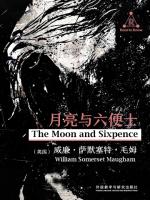The wildest dream,
Katrina/H
The wildest dream, the greatest man It is a truth universally
acknowledged that a man who has a seemingly successful life must be in
want of no big changes in the rest of his life. Nevertheless, Strickland
has a totally different choice. Do you hold a dream in your life?
Will you persist in realizing your dream even it may overturn everything
in your life? Strickland, the main character in The Moon and Sixpence,
may just sneer at these questions if he is asked, for the reason that he
is exactly the one who has decided to devote the rest of his life to his
wildest dream--to be a painter, whatever the costs. The Moon and
Sixpence, which I have read recently, is a classic novel written by W.
Somerset Maugham. Its theme concerns with art and mundane life as well
as the personal and social life. Through the creation of Strickland, the
author expresses the attitude that some grand achievements should be
made alone without worldly disturbance and such thing as feeling lonely
is unavoidable. The ideas, which were distinctive at that time,
construct a spiritual garden in readers’ mind. As for the plot, the
whole story is by and large based on the life experience of Paul
Gauguin, who is one of the greatest impressionists in the world. As a
result of Gauguin’s winding life, the plot is quite complex. It tells a
story about Strickland, who used to be a British stock exchange’s agent,
abandoned his present life in the middle age in order to chase after his
dream of being an artist. He left England and went to Paris, enduring
poverty and hunger as well as uncertainty of his dream. Finally, the
hero went to Tahiti and isolated himself from the civilized world. By
doing so, he eventually found the peace and freedom of his soul that he
had been longing for this many a day. Under such circumstances, he
created pictures that would be shocking to the later world but also
chose to destroy them all alone with his death. When it comes to the
artistic features of the story, author adopted the first perspective.
Therefore, readers can develop a picture of Strickland’s life through
“my witness” and at the same time, the author is provided with more
convenience to convey his attitude and emotion. Written in the first
hand also does great help to shorten the distance between author and
readers. In the view of the general public, Strickland is such an
irresponsible and selfish person. He merely considered himself and
discarded his family in order to fulfill his own dream. What is even
more difficult to understand is that it is an illusory, crazy and
somehow ridiculous one. However, realizing the dream is as great as it
is crazy. Through the journal, Strickland confronted with people’s
puzzlement, criticism and prejudice on his choice. Nevertheless,
Strickland wasn’t the kind of people who really cared about secular
vision. When it comes to his dream, he did have inexhaustible courage.
He enjoyed to be himself and kept running on his way once he had made
the decision. These distinctive personal traits make him adorable and
great. Maybe it is exactly what the book wants to convey: there is
only one way for one certain people. If you adore the bright moon, then
forget about the pence. If you want to pick up the pence on the ground,
then part with you fantasy about the moon. Your desire for everything
will eventually bring you nothing for you are hardly lucky enough to
have both. Therefore, just make up your mind and do not let yourself
regret about your choice. Once you make your decision, just chase after
it to the best of your ability because only in that way can you really
find the distance between you and your dream disappearing. In short,
Strickland is a mixture of craziness, wildness and freedom. He is the
kind of person who possesses great inspirit. It is these traits that
make Strickland a great artist. And it is all inspired by his wildest
dream. Moon and Sixpence tells the world that the wildest dream makes
the greatest man.



 京公网安备 11010802032529号
京公网安备 11010802032529号